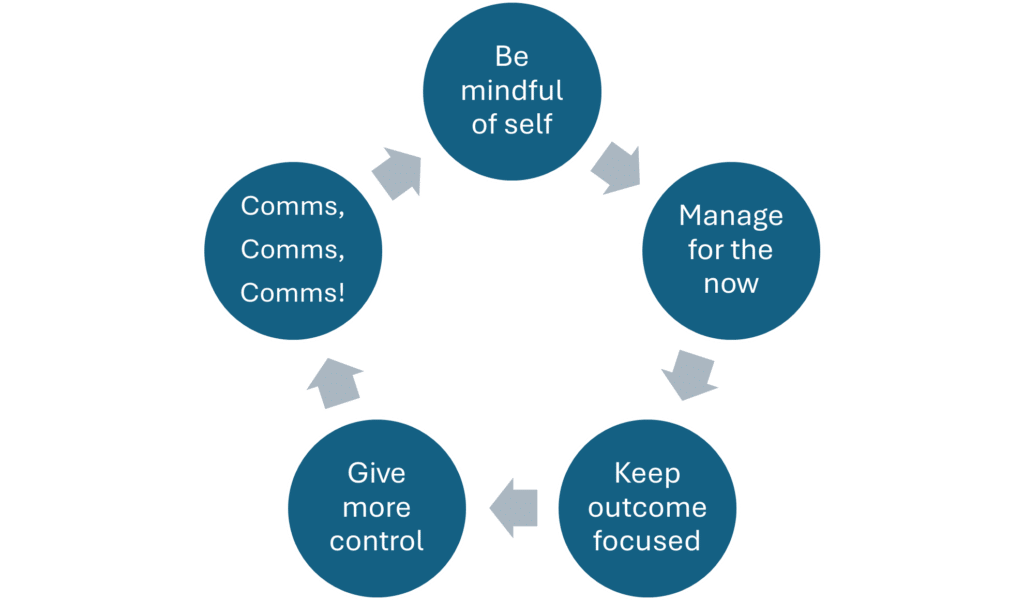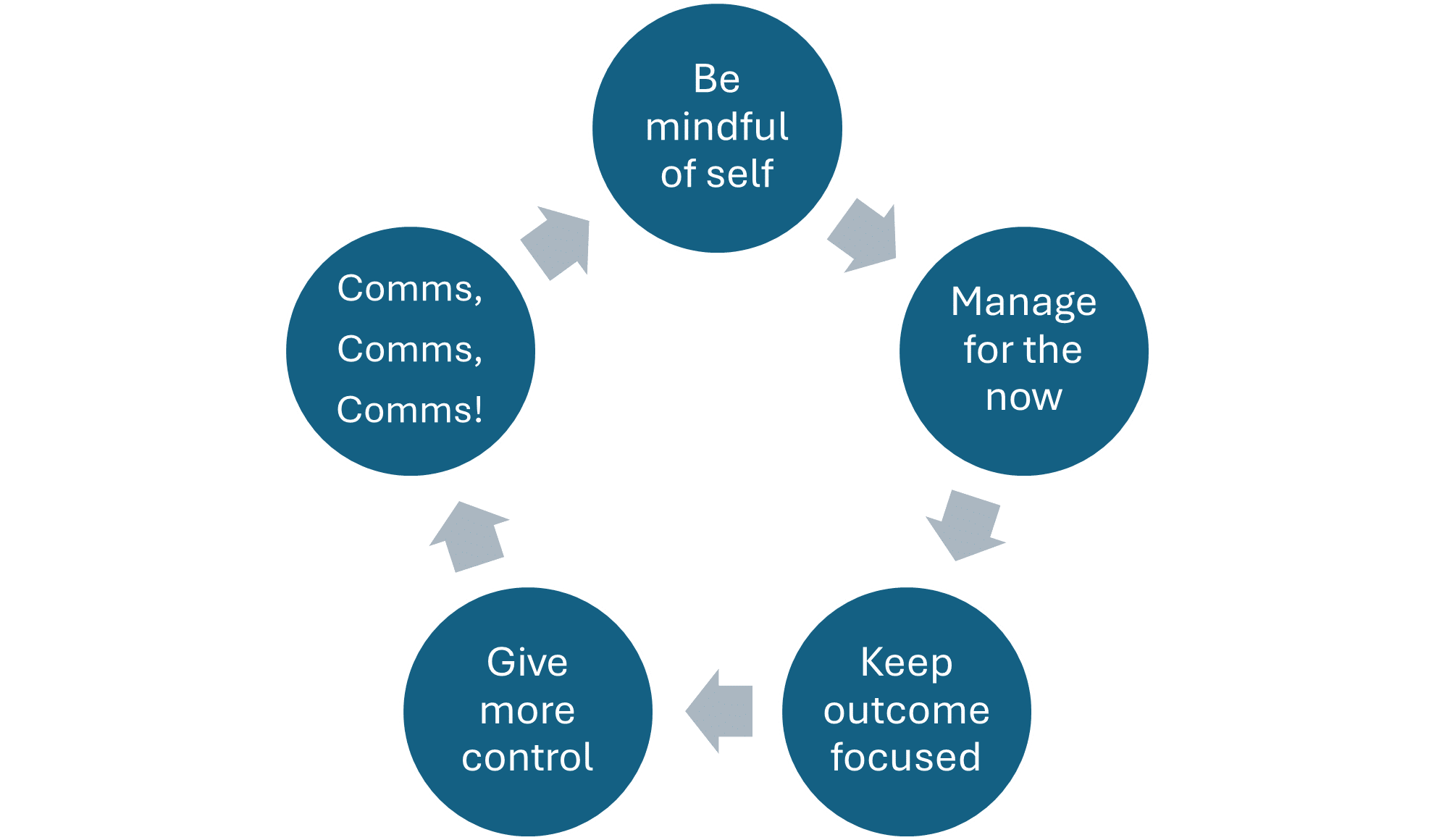Lead for Results!
One thing we are hearing frequently from our clients these days is “I just want my team to get on with it!”
The past few years have been focused on wellbeing, empathy and have been very employee centric. And that has been appropriate. We have all learnt a lot and are better leaders because of it. But right now, with the economic challenges businesses face many of us just need our team to get things done – bring in the sales numbers, get products out on time, and contribute effectively to the organisation.
But it is easier said than done.
Our teams may also be doing it tough. They may be stressed about the cost of living. They may be tired and still coming down from the adrenaline rushes the last few years of panic have caused. It could be a myriad of things, but the upshot is that they may just not be that motivated to perform well.
The good news is that you can change this without banging your fist on the table or resorting to disciplinary processes.
Adapting your leadership style to what you team needs right now will bring positive results for both your team and your business.
It is time to Lead for Results!

- Be mindful of self – How are you feeling right now? Are you motivated? Are you action oriented? You might be feeling the same as your team, which you may be projecting on to them. Be mindful of your own well-being and energy so you are role modelling the behaviour you want to see.
- Manage for the now – In a period of low motivation, thinking about long term goals can be challenging. Everything seems so far away, and you can always start tomorrow. Keep your focus short term and immediate. Focus on actions and outcomes you want right now so your team have the impetus to get cracking today. Small regular successes will also provide them with positive reinforcement to enhance motivation as they see and feel progress being made.
- Keep outcome focused – There is a lot to do, with many people doing different things. Don’t sweat the small stuff. Pick and choose what you focus on and make sure you know what is important. This will keep your team focused, on track and clear on what needs to be achieved.
- Give more control – Times are tough for some people, with external factors like the economy, food prices and mortgage increases being out of their sphere of control. When there is change or the creation of stress that seems beyond our control, many people move into a stage of inaction. You may be seeing the results of this with your team. So, give them more control like allowing them to choose their hours, their working pattern or have them lead team meetings if appropriate. The more you put into their circle of control the more positive action they can take and the more motivated they will become.
- Communicate, communicate, communicate – Don’t assume you can set your team goals and send them merrily off to achieve them. Keep the communication frequent and on point. Constant feedback, discussion and reminders of what is important and what you need from them will be critical to getting them action oriented.
In some instances, this won’t work, and you will have to have more formal discussions. However, this doesn’t have to be your starting point. If you adapt, so will your team – and everyone becomes a winner when that happens.
Positive People have over 25 years’ experience helping businesses create high performing teams.
Call us today on 09-455 1077 to find out how we can help you.
Is your organisation “right sized”?
Cash flow projections can get you thinking and force you to look for cost savings.
No-one wants to look at their staffing efficiencies, but with wages and salaries often the biggest cost for a business, it is unfortunately imperative to do this to ensure this is money well spent.
It can be that you look around your workplace and think “Why is that person always so flat-out busy?” or alternatively “How does that person fill their day?”
Work has changed over the past few years, and with it the demands and tasks for your teams may have changed too. It is important that you have balanced roles and workloads.
“Organisational structures of today demand too much from a few, and not much at all from anyone else.”
(Gary Hamel)
Being right sized doesn’t necessarily mean reducing the size of your team.
It is about making sure you are well organised and have the right resources focused on the right priorities to successfully achieve your business goals.
If you want to make sure you have a “right sized” team, here are a few key pointers:
- Your overall organisational structure – Is this aligned with your vision and goals? Is it best designed to make sure you have the teams working together and achieving what they need to achieve? Should teams be working closer together or could your structure be arranged differently to get better results?
- Role size – Workloads have changed considerably over the past few years with the challenges we have faced, and this may have caused some of your roles to be unbalanced. Has the workload increased in any areas, or decreased in others? Does anyone seem overworked? Or underutilised? Are some departments struggling to complete everything they need to? This may mean some tasks should be reallocated, some roles re-scoped, others could be merged, or a more significant change may need to take place.
- Clear accountabilities – Is every single person in your organisation crystal clear and focused on their key accountabilities and outcomes? Do they know how these relate to your overall business performance? If you cannot articulate what these are for each role, chances are your team can’t either. This may mean they are spending time on the wrong things, rowing in a different direction to the rest of the crew – or on a different boat altogether!
- System efficiency – What can you automate, and what processes can be improved to save time? Imagine how much impact some of your team could have if they were working on business improvements rather than completing administrative tasks? Or how many $$ you could save over the next few years if you could reduce paperwork and inefficiencies? It is worth reviewing and investing in as you get set for the future.
- Options for true workforce flexibility – Many jobs and tasks don’t need to be performed for 40 hours a week every week. You will have peaks and troughs and changes to requirements will shape these hours. Are you flexibly set up to take advantage of this or are you paying a salary even when there is no work to be done? Consider outsourcing, contracting and casual resourcing. These options can be far more cost effective and give you “right sized” flexible coverage when you need it.
Positive People have over 25 years’ experience helping businesses set up the right structures to align with your business goals. We can help you “right size” your organisation, then guide you successfully through any processes required to put the changes in place and offer you flexible resourcing in the HR space. Call us now to discuss your requirements.
Are your team on board?
New year – new you! It’s that time of year, isn’t it?
With the sun shining and a proper summer under our belts, it’s time to settle back into routine and get back to business. Many of us come back from the break with an added vigour for reaching our goals, moving forward, and setting ourselves and our businesses up for success.
But are your team on the same path as you?
You might be enthusiastic and have a clear path ahead of you, but no employer can achieve their goals without the commitment and efforts of the people around them. Just as important as your business planning is taking the time to think about what your people need and how you can inspire them to take the journey with you.
“If everyone is moving forward together, then success takes care of itself.”
Henry Ford.
Easier said than done right?
Here are some ideas to consider, to make sure your team are fully on board and with you every step of the way:
1. Communicate your vision and plans – A key starting point for having your team on board is to make sure they know where you are going, why it’s important and to help them feel excited by the possibilities.
Often Companies approach their vision like a “one and done” exercise – one presentation and everyone will know it, be brought in and working towards it. Not so.
Now is a great time to re-energise your team by taking about your vision, helping them to understand the difference your business can make and feel excited for the year ahead.
2. Develop your WIFM – You care about your plans, your Board will care, your management
team will care – but do your people? And why should they? Think carefully around how your
business success will benefit them. It may for the greater good, for financial success or job
security. Whatever the reason is, be clear and communicate this. Your team also need a
reason to care.
3. Create an HR plan – Having a strong HR foundation which creates a great workplace will help
to foster motivation and encourage your team to support you. Reviewing your current HR
practices, identifying improvement areas, communicating your plan and following through
on it is key. It will help your team to see that they are important as well, make them feel
valued and encourage commitment to the business.
4. Check your engagement levels – The start of the year is different for everyone. Some feel
energised, some feel ready for change – and some just want to go back to the beach! A pulse
survey helps you check the mood and put some “quick wins” or initiatives in place which can
refocus and energise your team.
5. Communicate, communicate, and communicate some more – Once again, “one and done”
won’t get you the best results and commitment you need for success. Review your
communication methods and make sure they line up with where you want to go this year.
Do you include regular business updates, town hall events, celebrations of success and
milestones? Once you have your team committed to your goals, you will need to have a plan
to keep them with you throughout the year.
“The bigger the dream, the more important the team. “
Positive People have over 25 years’ experience helping businesses motivate and engage their teams.
We partner with you to create HR plans which support business success. Contact us now to find out more.
SENIOR LEADERS – MAKE SOME TIME FOR YOURSELF!
Isn’t it time to have a think about yourself?
As we round the corner and the year-end comes into view, Senior Managers need to take some time to think about themselves and reflect on what they want for 2024. This applies equally to your world of work as well as personally.
Most leadership time is spent putting a lot of effort into strategising, planning, and managing people and projects. These become all consuming, and hours of intense and incredibly demanding work stretch into days, which become weeks and then all of a sudden the month is gone, and the next month’s work is starting to build pressure. Soon it is year-end.
Locked into an adrenalin rush of successful work, this pattern morphs into the new normal.
The one catch, though, is that it is unsustainable, and, in the end, something has to give. It may be poor decision making, it may be overly emotional responses, it may be lack of perspective, it may be impatience, it may be health, it may be domestic tension.
Healthy life patterns become compromised by the whirlpool of work. This type of never-ending cyclical work pattern can make you feel like a stranded whale, without any chance of getting back in the water.
As a leader, this can feel like a lonely place to be.
So, what to do?
Take stock of your own time management.
- Are you as organised as you should be? Are you regularly – by that we mean throughout your day, week, month – prioritising tasks or is the river of demand catching you in its pull? And sending you into other people’s swirls that are difficult to get out of? Simple techniques to stay on top of work can be lost in the busyness of everyday. It needs constant self discipline to stay ahead of the game.
- Are you delegating appropriately? Or do you just put your head down and keep on keeping on? Do you use the demands placed on you as an opportunity to delegate tasks and jobs to others? This gives them the opportunity to grow and develop, which most employees want. It is a little like pay now, fly later, but surprisingly you will fly sooner than you think and then will have someone relieving the pressure on you.
- Are you constantly appraising the benefit of your own meetings and also then selecting the meetings that you will attend? Are these meetings the ones that really matter? Are these agenda driven and time bound? Or have a number of them become meandering talk fests, perhaps dominated by one or two personalities? Analyse the efficiency of meetings. It can free up a huge amount of time. Don’t allow meetings to sink into an unchallenged routine. Review them every 3 months so that a focus remains on the outcome and productivity of each one.
- Find some inspiration so that each day seems bright. Are you feeling weighed down and flat? Seeking and riding aboard some new ideas and different ways can not only inspire you but can also lead to much better ways of doing things. It really is important to be constantly looking and searching for improvements in everything you are involved in and have control over. Don’t get complacent. There are always better ways! Part of this looking for inspiration also relates to making sure that your own attitude is positive and optimistic. Managing people demands this. So, take some time to feed yourself in what ever way gives this to you.
- Focus on your own health. Set some personal health goals, be they physical or mental, and then develop an action plan to keep you on track and always heading in the right direction. Prioritise your health. It sets you up for success in all aspects of your life and has a positive impact on people around you.
Positive People have over 25 years helping leaders organise their time for best results. Call us now on 09 445 1077. We are here to help.
MANAGING IN THIS TOUGH BUSINESS ENVIRONMENT
The months prior to an election are always full of uncertainty. Throw in the after effects of a global pandemic, heavy flooding, a cost-of-living crisis and a very long wet winter and the end of the year is proving to be tough for businesses and employees alike.
But whatever the results come election day, most people are looking for stability and to feel like there is light at the end of the tunnel. As more of your team start to feel the effects of negative impacts like increased mortgage rates and food prices, overwhelmingly they are looking for solutions to their current issues, and for the Government to just get on with fixing things.
This year we have seen changes in employment matters across all the industries we deal with:
- Unrealistic pay expectations – Remember when 3% was a good annual pay increase? Not anymore! Compared to CPI, inflation levels and the increase in market rates, 3% just isn’t cutting it for most employees anymore and you may get push back. We understand that last year you may have been generous, but costs are increasing for businesses as well, so this year matching the CPI is a lot tougher.
- Higher levels of absenteeism – It seems the increased level of absenteeism caused by Covid is sticking around. While most businesses anticipated absenteeism returning to normal levels, the increase to 10 days sick leave and the number of bugs around this year haven’t seen this happen. We know this places pressure on businesses and is a constant frustration.
- Increased number of Personal Grievances – Employees appear to be far more aware of their rights, and justified or not, the number of PG’s being raised has risen. Stress and financial pressure play a role in this, as tempers are shorter and patience levels are reduced.
- An increased number of performance issues – When people are stressed their ability to rationalise and think through the consequences of their actions suffer. The focus for many people is on personal and financial issues and this impacts work performance,
People are stressed, patience is thin and it is a tough environment for business.
So, what can you do to navigate successfully through this period and support your team and your leaders?
- Stay close to your people – Even those employees who you think are financially secure may be facing financial or personal pressure right now, so don’t assume anything. Be aware of signs of stress, changes of behaviour and standards of performance. If you can understand the reasons behind this, you can support them through it and build long term engagement and commitment to your business.
- Reconsider your well-being offerings – There are many interventions that can go in your well-being plans, but are they right for what your team need now? Consider financial planning support or having financial support resources available. What about wellness days for when things become a bit much and they need a day to decompress? Do you have overtime you can offer, or can you allow flexibility to help cut childcare costs? Ask your team what would support them most. Then target that with your support.
- Communicate well – Part of your team’s stress could come from their fears on job security and their future in your business. Make sure you lead from the front, acknowledge their concerns, and communicate a strong message around your future. Through your communication you can build a united, supportive, and focused team, which is a workplace plus that everyone could benefit from right now.
- Be strategic with your salary increases – It may be tough to give the increases your team are asking for, so you may have to make some tough choices and try a different approach. Who can’t you afford to lose right now? Who is critical to your business success? Who do you need to retain for the future? Making sure your talent is well rewarded will reduce your business risk and help your business continuity.
- Take care of yourself – Leading a business has been a tough job over the past few years and will continue to be. It is normal to feel the pressure yourself. Caring for your team, making the right decisions and dealing with financial demands all contribute. Be purposeful in doing the things which reduce your stress levels, energise you and give you joy. Keeping yourself well will make you a better leader for your team.
Positive People have over 25 years’ experience helping businesses build high performing teams and navigate through business challenges. Call us now and we can help you make a plan that’s right for your business, and supports your business success.
CREATING A CULTURE OF CARE
Wellness has become a hot topic in the last few years. In the workplace, the topic of Wellness needs to be seen not only against the commercial imperatives of having well and healthy team members and the compliance risks of transgressing relevant legislation, but also in the light of the expectations that employees increasingly have in working for an organization that truly values and cares for them.
The reality is that employees’ expectations go beyond just compliance with legislation. Doing the minimum may keep you out of trouble in the event of an accident, but misses the chance for you to show that you really care about your people and that your Health & Safety program is not about begrudgingly meeting minimum requirements imposed on your business, but is rather a pro-active internal initiative that beds Wellbeing into your culture.
It is about creating a culture of care where there is a strong Wellness value backed by robust policies and actions that resonate for all employees and demonstrate to them that their employer cares about them in a genuine way.
The backdrop to the Wellness and Wellbeing momentum is the huge challenge we are facing environmentally. We cannot ignore this elephant in the workplace any longer. The people within our organisations are feeling the environmental vibrations and as business leaders we need to listen to what is being said and be pro-active in creating operational programs that help alleviate these issues that are exerting pressure on our environment.
Are you in the basic Health & Safety space where you simply comply with what the legislation demands?
Are you in the Voluntary Health space, offering programs that include providing access to a broad range of fitness and healthy living programs like assisting workers improve their fitness, reduce/quit smoking, or alcohol intake, and generally improve their personal health?
Are you are in the Organisational Culture space which is about targeting workplace factors that directly impact on the psychological health of workers and may include initiatives related to the way work is organized, flexibility, work content, the quality and meaningfulness of work, the hours, access to training and improvements to a broad range of workplace factors?
Are you looking ahead and seeing that the space that employees and organisations alike are increasingly going to move into will be the Environmental Change space which acknowledges that the welfare of employees is inextricably linked to the health of the planet? Many of our employees are already here, and many more will inevitably get here soon. Initiatives may include educating your staff by bringing in speakers on the positive value of reducing, re-using and recycling plastics, producing Company logoed re-usable cloth bags for staff, customers and suppliers, and for distribution at company PR events, having a zero tolerance program towards littering in the workplace and having volunteer work teams at local beach clean-up events followed by a Company BBQ. Hybrid and Electric Vehicles are also becoming increasingly commercial.
These practical examples illustrate to your people that you care about them, you care about the world that they live in and that as a Company you are going to work with them to do something about it.
Creating a culture of care starts with a stated Wellbeing value that shines through operational initiatives and spans across the Health & Safety, Voluntary, Organisational and also the Environmental touchpoints in your business.
It comes down to creating a culture that engages and resonates with your employees. A culture that meets their expectations in a fast changing world, and a culture which shows them that you really do care.
Positive People have over 25 years helping businesses create a culture that engages and resonates with your employees. Call us now on 09 445 1077. We are here to help.
Managing the hostile employee

He is a workhorse who knows his stuff inside out. Customers and suppliers alike respect his commitment to their needs. He is knowledgeable and will go the extra mile to help them, always. He is respected for the work he does and for the value he passes on to customers.
Sound like an ideal employee?
Actually no, because he terrorises some of those within the organisation with his aggressive, righteous, threatening and intimidatory behaviour.
It goes something like this:
The office is quiet and everyone is busy at their work stations. Out the blue comes the barking “WHY are you doing that? If I’ve told you once, I’ve told you a hundred times before, DON’T DO IT THAT WAY!”
A shake of the head and he’s gone.
The team sit in silence pretending this didn’t happen. The embarrassed victim looks down and tries to keep her composure but is obviously upset. She turns a bright red, shuffles her desk things nervously and then quickly scuttles out of the office. Her colleague quietly leaves and follows her. The regular routine of tears and angst follow.
As a responsible employer, what do you do?
This is a technically competent, committed employee who adds great value to the company. You don’t particularly want to upset him. Whilst you may have pretended to ignore the incident and glossed over this type of unacceptable behaviour, the whispers around the office were enough to appear on your radar and you know you should have done something. It was just too hard! And, it is true, the guy is very difficult to confront.
The first thing to know is that you cannot leave this situation to stand as it does. Health and Safety requirements dictate that this situation is addressed. Leaving it because it is too hard won’t do. There is a responsibility under the Health and Safety in Employment Act to ensure that you provide a safe work environment for all your team, and allowing this type of behaviour to exist is contrary to that. It also undermines the values and culture that you might be trying to create and maintain in your business.
It is an absolute non-negotiable that anyone in the business should not have to endure aggressive, threatening, abusive, intimidating, bullying or harassing behaviour from anyone in the organisation.
So, what are the solutions to this all to frequent problem?
Starting from the basics, within your foundation employment documents, there needs to be a Code of Conduct and a Health and Safety policy that clearly sets out the organisation’s behavioural expectations of employees. Bullying and Sexual Harassment policies also play their part in setting standards of acceptable behaviour. Having appropriate documents properly established at the outset of employment provides the correct reference and starting point for the behaviour that you expect from employees. Reinforced by your Values and Culture Statement, you have a solid foundation from which to manage behaviour within the business.
Having these fundamental building blocks in place allows you to reinforce your behavioural (and performance) expectations at Performance Reviews as appropriate. Additionally these can be re-stated, as required, at regular individual One-on-one meetings, Team Meetings and at State of Nation communication sessions. In this way you are regularly emphasising the importance of good behaviour at both an individual and group level, and keeping your Values top of mind.
For most, these communication channels are enough to set the boundaries of acceptable behaviour. However, it can often be that the hostile employee does not see their own behaviour as unacceptable and is simply blind in their righteousness, and views the achievement of the task as paramount, irrespective of the ructions that may result, if they even notice them.
If unacceptable behaviour does manifest itself, then the offending employee needs to be quickly brought into line. This usually only requires a quiet, but very firm early word outlining the specific instance of unacceptable behaviour, drawing attention to the Code of Conduct and set of Values, accompanied by a reminder that any further instances will not be tolerated and will most likely result in the application of the disciplinary procedure.
Simply, the hostile team member needs to know very clearly and very early that whatever they are doing will not be tolerated. Problems with a hostile employee often fester because the behaviour is left and because the behaviour comes and goes, everyone hopes that it will simply “go away”. Unfortunately this passive inaction just encourages more of the same, and it is often the more junior staff who take the brunt of the bullying, threats or discourtesy. To condone such behaviour not only kills the positive culture in the business but is against the law. It is also manifestly unfair on the victims.
Anger and other forms of intimidatory behaviour in the workplace have no place and the responsibility to manage the hostile employee rests fairly and squarely with the employee’s Manager who has daily contact and sees the unacceptable behaviour in operation. Sweeping it under the carpet or ignoring it is not an option. The Manager has to front up and deal with it.
Is your business condoning bad behaviour?
Positive People has over 25 years pf assisting businesses set up effective individual and group communication channels and policies to address this type of difficulty. Call us now on 09 445 1077. We are here to help.












